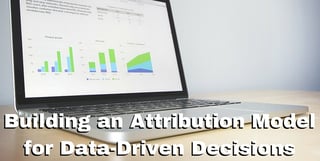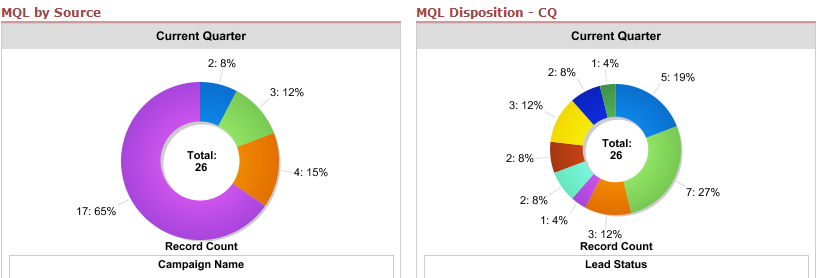

A marketer in today’s digital age faces three main challenges: 1) keeping up with constantly evolving tools, trends, and channels; 2) sourcing enough caffeine to power their creative engines; and 3) implementing any sort of attribution model that effectively tells the story of their team’s efforts.
While many folks have figured out solid strategies for the first two items, the third one remains somewhat of an elusive objective. If you don’t have a solid grip in your understanding of attribution, you most certainly are not alone.
The majority of marketers cannot determine with any degree of certainty the value of each touchpoint or channel during each prospect’s buying journey. The result of this is the inability to establish whether or not they’re effectively using their budget and optimizing revenue.
Marketing attribution, the proper assignment of credit to a particular marketing touchpoint, has never been more complicated or more important with the layers of complexity added by the explosion of marketing channels and tools. I recently had the opportunity to put together an implementation plan for a basic attribution model between two very powerful marketing and sales platforms: HubSpot and Salesforce.
Below, I’ve outlined the approach we recently put together for one of our clients, a publicly-traded organization in the commercial real estate industry.
- We started by identifying the main problem and the consequential issues that resulted.
Problem: A CRM full of legacy data and fields from platforms of the past that wasn’t able to communicate with the marketing platform and vice versa, which led to:
- A lack of attribution across teams and channels
- Reduced pipeline visibility
- Misalignment between the sales and marketing teams
It will be important for us to track marketing attribution inside of Salesforce so that we can see how the marketing team’s efforts stack up in the overall picture when considering all the channels that leads come through – sales prospecting, tradeshow networking, hosting events, etc.
- We put together a plan of action to address the main problem, with a subsequent two-phase strategy to build the foundation for proper attribution.
Plan of Action: Implement and optimize the integration between HubSpot and Salesforce, relying on an inclusion list inside HubSpot to control the flow of data between the two platforms.
- Implementation of the HubSpot <> Salesforce integration
- Optimization Phase 1: Salesforce
- Condense the lead source picklist from 83 options to 8 options
- Assign leads/contacts to associated campaigns to preserve current lead source information
- Include an info hover on lead source dropdown for global clarification
- Optimization Phase 2: HubSpot
- Audit forms to identify opportunities for auto lead-source assignment and implement accordingly
- Build out campaigns to track attribution across individual marketing channels
- Update lifecycle stages criteria
- Attribution Report Build-Out
- Create three custom reports inside of Salesforce
- Leads by source
- SQLs by source
- Customers by source
- Create three custom reports inside of Salesforce
Optimization Phase 1 Detail
During phase one of the integration optimization process, it will be important to identify the actual channels through which leads enter the database – the lowest common denominators, of sorts. With 83 different lead sources in there currently, the attribution picture is very fuzzy at best.
However, it is important to our client to preserve the current lead source information on the contact’s record. To do so, we’ll build out a series of Salesforce parent and child campaigns based on the lead sources and then assign campaign members appropriately. Many of these, for instance, are specific conferences or tradeshows that can funnel up into a broader lead source of “Conference/Tradeshow.”
Moving forward, it will be critical for all team members to understand the new lead source values and when to use them. We’ll keep everybody on the same page by creating an info prompt with definitions and use cases for each that appears when a user hovers over the icon next to the field. This information will also be part of a Sales Playbook that new employees receive to establish stricter data governance.
Optimization Phase 2 Detail
Moving into phase two of the integration optimization process, it will be important to distinguish all the points of lead entry and determine exactly how their lead source will be defined & assigned in both HubSpot and Salesforce. For instance, if a lead comes through a particular social media campaign to register for an upcoming event that our client is hosting, we will want to assign that lead the proper HubSpot campaign and the correct lead source so that marketing gets credit for generating that lead in the Salesforce attribution report.
Phase two will also be a good opportunity to update the criteria of our lifecycle stages so that pipeline visibility and lead tracking are more accurate across both platforms.
Attribution Report Build-Out Detail
Once the foundation has been completed, we will create the reporting model to ultimately help our client understand where their lead generating resources are most effective. By tracking lead sources across leads, SQLs, and customers, we can begin to identify strengths and weaknesses in our SMARKETING efforts. Here's a similar type model that we've worked on with another client:

For example, if a large proportion of leads come in from “Inbound Marketing,” but a larger proportion of SQLs come from “Web Prospecting,” we can draw some hypothesis around our lead nurturing efforts. In that case, we could then make some tweaks to our lead nurturing workflows to test our theory. Or, if a large percentage of customers are attributed to “Sponsored Event,” the marketing team may receive a larger budget going into 2017 to host more events.
Prove Your Team's Value
As a marketer in today's digital conditions, it is critical to understand and evaluate the output of your team's efforts on a regular basis. With a finely-tuned attribution model in place, you'll be able to quickly recognize successes and missteps to ensure you're using your resources most effectively. It will also provide the data you need to prove you team's value when it comes to measuring ROI on each lead-generating channel.
We are very anxious to launch our plan and we’ll be working diligently through 2Q16 to implement. Stay tuned for an update on the fruits of our labor going into 3Q16!
